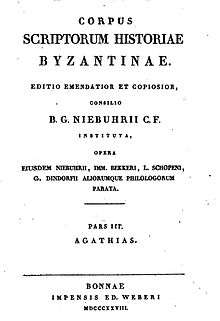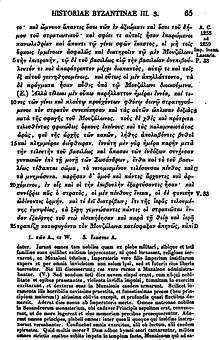Corpus Scriptorum Historiae Byzantinae


The Corpus Scriptorum Historiae Byzantinae (Latin: Corpus of Byzantine history writers), frequently referred to as the CSHB or Bonn Corpus, is a monumental fifty-volume series of primary sources for the study of Byzantine history (c. 330–1453), published in the German city of Bonn between 1828 and 1897. Each volume contains a critical edition of a Byzantine Greek historical text, accompanied by a parallel Latin translation. The project, conceived by the historian Barthold Georg Niebuhr, sought to revise and expand the original twenty-four volume Corpus Scriptorum Historiae Byzantinae (sometimes called the Byzantine du Louvre), [1] published in Paris between 1648 and 1711 under the initial direction of the Jesuit scholar Philippe Labbe.[2] The series was first based at the University of Bonn; after Niebuhr's death in 1831, however, oversight of the project passed to his collaborator Immanuel Bekker at the Prussian Academy of Sciences in Berlin.[3]
While the first volume of the series was praised for its "minute care and attention" to textual details,[4] later volumes produced under Bekker became infamous for their frequent misprints, careless execution, and general unreliability.[5] Given these shortcomings, the International Association of Byzantine Studies established in 1966 the Corpus Fontium Historiae Byzantinae to re-edit many of the texts included in the Bonn edition of the CSHB.
Volumes
- 1: Agathias, ed. Niebuhr (Bonn, 1828)
- 2: Anna Comnena, ed. Schopen, vol. 1 (Bonn, 1839)
- 3: Anna Comnena, ed. Reifferscheid, vol. 2 (Bonn, 1878)
- 4: Michael Attaliota, ed. Bekker (Bonn, 1853)
- 5: Ioannes Cantacuzenus, ed. Schopen, vol. 1 (Bonn, 1828)
- 6: Ioannes Cantacuzenus, ed. Schopen, vol. 2 (Bonn, 1831)
- 7: Ioannes Cantacuzenus, ed. Schopen, vol. 3 (Bonn, 1832)
- 8: Georgius Cedrenus, ed. Bekker, vol. 1 (Bonn, 1838)
- 9: Georgius Cedrenus, ed. Bekker, vol. 2 (Bonn, 1839)
- 10: Laonicus Chalcondyles, ed. Bekker (Bonn, 1843)
- 11: Chronicon Paschale, ed. L. Dindorf, vol. 1 (Bonn, 1832)
- 12: Chronicon Paschale, ed. L. Dindorf, vol. 2 (Bonn, 1832)
- 13: Ioannes Cinnamus, Nicephorus Bryennius, ed. Meineke (Bonn, 1836)
- 14: Codinus Curopalates, ed. Bekker (Bonn, 1839)
- 15: Georgius Codinus, ed. Bekker (Bonn, 1843)
- 16: Constantine Porphyrogenitus, ed. J. J. Reiske, vol. 1 (Bonn, 1829)
- 17: Constantine Porphyrogenitus, ed. J. J. Reiske, vol. 2 (Bonn, 1830)
- 18: Constantine Porphyrogenitus; Hierocles, ed. Bekker, vol. 3 (Bonn, 1840)
- 19: Dexippus, Eunapius, Petrus Patricius, etc., ed. Bekker and Niebuhr (Bonn, 1829)
- 20: Ducas, ed. Bekker (Bonn, 1834)
- 21: Ephraemius, ed. Bekker (Bonn, 1840)
- 22: Georgius Syncellus, Nicephorus Cp, ed. L. Dindorf, vol. 1 (Bonn, 1829)
- 23: Georgius Syncellus, Nicephorus Cp, ed. Dindorf, vol. 2 (Bonn, 1829)
- 24: Michael Glycas, ed. Bekker (Bonn, 1836)
- 25: Nicephorus Gregoras, ed. Schopen, vol. 1 (Bonn, 1829)
- 26: Nicephorus Gregoras, ed. Schopen, vol. 2 (Bonn, 1830)
- 27: Nicephorus Gregoras, ed. Bekker, vol. 3 (Bonn, 1855)
- 28: Historia Politica et Patriarchica Constantinopoleos; Epirotica, ed. Bekker (Bonn, 1849)
- 29: Ioannes Lydus, ed. Bekker (Bonn, 1837)
- 30: Leo Diaconus, etc., ed. Hase (Bonn, 1828)
- 31: Leo Grammaticus, Eustathius, ed. Bekker (Bonn, 1842)
- 32: Ioannes Malalas, ed. L. Dindorf (Bonn, 1831)
- 33: Constantinus Manasses, Ioel, Georgius Acropolita, ed. Bekker (Bonn, 1837)
- 34: Merobaudes, Corippus, ed. Bekker (Bonn, 1836)
- 35: Nicetas Choniates, ed. Bekker (Bonn, 1835)
- 36: Georgius Pachymeres, ed. Bekker, vol. 1 (Bonn, 1835)
- 37: Georgius Pachymeres, ed. Bekker, vol. 2 (Bonn, 1835)
- 38: Paulus Silentiarius, George Pisida, Nicephorus Cpolitanus, ed. Bekker (Bonn, 1837)
- 39: Georgius Phrantzes, Ioannes Cananus, Ioannes Anagnostes, ed. Bekker (Bonn, 1828)
- 40: Procopius, ed. K. Dindorf, vol. 1 (Bonn, 1833)
- 41: Procopius, ed. K. Dindorf, vol. 2 (Bonn, 1833)
- 42: Procopius, ed. K. Dindorf, vol. 3 (Bonn, 1838)
- 43: Theophanes Confessor, ed. Classen, vol. 1 (Bonn, 1839)
- 44: Theophanes Confessor, ed. Classen, vol. 2; Anastasius, ed. Bekker (Bonn, 1841)
- 45: Theophanes Continuatus, Ioannes Cameniata, Symeon Magister, Georgius Monachus, ed. Bekker (Bonn, 1838)
- 46: Theophylactus Simocatta, ed. Bekker (Bonn, 1834)
- 47: Ioannes Zonaras, ed. Pinder, vol. 1 (Bonn, 1841)
- 48: Ioannes Zonaras, ed. Pinder, vol. 2 (Bonn, 1844)
- 49: Ioannes Zonaras, ed. Pinder, vol. 3 (Bonn, 1897)
- 50: Zosimus, ed. Bekker (Bonn, 1837)
See also
References
- ↑ The Life and Letters of Barthold George Niebuhr, ed. K. J. Bunsen, with J. Brandis and J. W. Lorbell (New York: Harper, 1854) p. 483, and letter 364 (pp. 501-502), addressed to Savigny, dated 29 April 1827: "You will have heard of the edition of the Byzantine historians, which I am superintending. It is a great delight to me to be able thus to infuse some life into our literary doings; to give employment to young philologists; to give extension, activity, and perfection to typography; to contribute my mite [sic] to the increase of general prosperity...."
- ↑ H. Omont, "La collection byzantine de Labbe et le project de J. M. Suarès", Revue des études grecques 17 (1904), p. 18
- ↑ D. R. Reinsch "The History of Editing Byzantine Historiographical Texts", in The Byzantine World, ed. P. Stephenson (New York: Routledge, 2010), p. 441
- ↑ "Niebuhr's Edition of the Byzantine Historians" The Foreign Review 1 (1828), p. 575. However, the anonymous reviewer does criticize Niebuhr for standardizing of Byzantine orthography along Classical lines
- ↑ Reinsch, op. cit., reports that August Heisenberg, professor of Byzantine literature at Munich, once said of Bekker that he "must have revised the texts 'lying on the sofa with the cigar in his mouth.'" J. B. Bury was even harsher in his assessment, calling the CSHB "the most lamentably feeble production ever given to the world by German scholars of great reputation." See: idem "Introduction", to Edward Gibbon, The History of the Decline and Fall of the Roman Empire, vol. 1, ed. J. B. Bury (London: Meuthen, 1897), p. xlix.
Further reading
- Irmscher, Johannes. "Das Bonner Corpus und die Berliner Akademie", Kretika Chronika 7 (1953), pp. 360–383.
- Reinsch, Dietrich R. "The History of Editing Byzantine Historiographical Texts", pp. 435–445. In The Byzantine World. Ed. Paul Stephenson. New York: Routledge, 2010.
External links
| Wikimedia Commons has media related to Corpus Scriptorum Historiae Byzantinae. |
- Digitized CSHB on the Documenta Omnia Catholica (Latin)
- Fordham Guide to Byzantine Sources in Translation